Anthurium, brown spots on the leaves - what to do, care rules
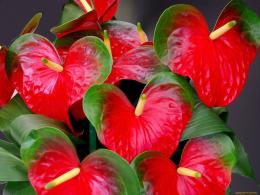
Anthurium is a tropical epiphyte; its ideal conditions are tropical rainforests. Therefore, in indoor conditions this plant is capricious, very demanding on soil, watering regimes, temperature and air, but this does not stop lovers of exotic plants.
Sometimes the flower gets sick and spots appear. The sooner you understand the cause of brown spots on anthurium leaves, the greater the chance of the plant being cured. We hope this article will help you understand this.
Content:
- Rules for proper care
- Difficulties in the growing process
- Errors in care
- Infectious diseases and pests
Rules for proper care
Anthurium record holder for duration flowering – under good conditions it can bloom for three or more months. The plant is spectacular, bright, grows well and quickly, subject to certain conditions.
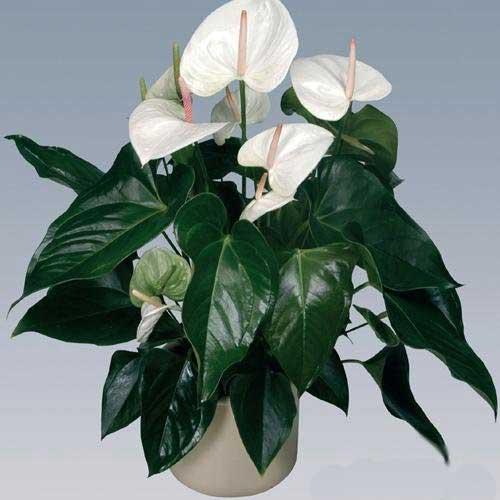
Since anthurium comes from tropical forests, it is necessary to organize for it:
- warmth and light
- soil and good nutrition
Proper watering
So, in order: warm, warm and warm again! Below 18 degrees is already the North Pole for him; in addition to the air temperature, the soil temperature is important - it should not be lower than the environment. If the flower is on a windowsill, then in winter, place a piece of fabric, cardboard or polystyrene under the flowerpot to prevent the roots from cooling. Direct sunlight causes burns; it can grow in the shade, but will not bloom. He needs diffused light.
The soil
Special the soil for anthurium is not sold, so you need to prepare it yourself:
- take equal parts of soil for the azalea,
- peat and baking powder,
- add some pine bark and charcoal.
Anthurium is suitable for soil with an acidic environment; soil for azaleas meets these requirements. River sand is best suited as a leavening agent, but you can buy any other sand in the store (perlite, vermiculite). To protect the roots from rotting, drainage is necessary - about 2-3 centimeters of expanded clay, broken brick or small stones are placed on the bottom of the pot.
Feeding
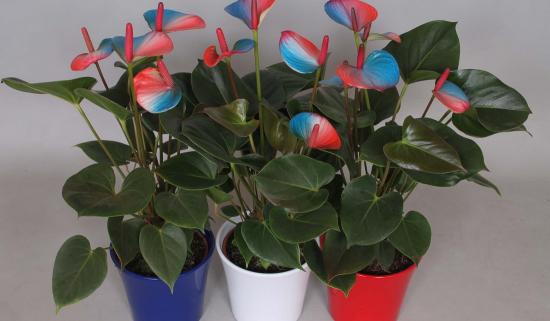
Anthurium requires good nutrition - give it liquid fertilizer once every 2-3 weeks, but do not overdo it, otherwise it will turn yellow. To do this, take three times less than the dose of fertilizer recommended in the instructions.
In winter feeding reduced or not carried out at all. Once a month, add citric acid to the water for irrigation at the tip of a knife so that the soil is slightly acidified.
The soil should be breathable and there should be no stagnation of water. If it stagnates, the roots quickly rot and the flower can die in a few days. The soil should be moistened, but not wet, and the water should always be poured out of the pan. Watering should be done after the top layer of soil dries slightly.
Difficulties in the growing process
Not all amateur gardeners manage to grow anthurium. A flower bought in a store at home begins to wither; if all the leaves are damaged, the flower almost always dies.
To prevent this from happening, you need a proper transplant:
- It is better to replant immediately after purchase
- Transplantation only by transshipment method
Many people do not advise immediately replanting plants bought in a store, but in vain.The roots are cramped in such small pots; the sooner the transplant is done, the faster the flower will get used to the new conditions.
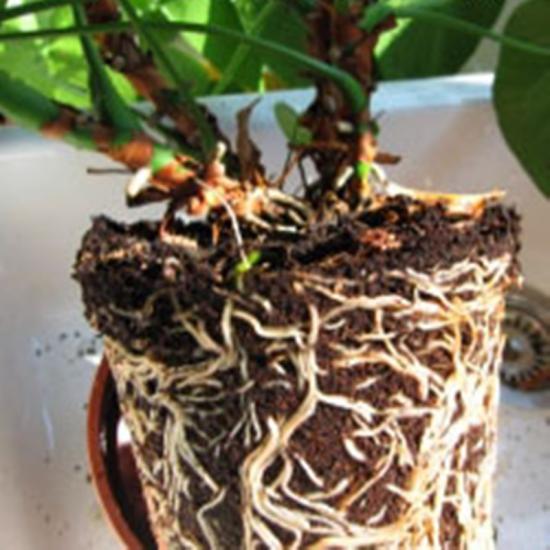
Most often, the plant suffers due to improper care, especially with regard to air humidity. The optimal air humidity in the room should be at least 70%, but achieving such a figure is very difficult.
Usually in residential premises it barely reaches 30%, which, by the way, affects not only plants, but also people, especially small children. Anthurium loves spraying, and the water should not be cold; room temperature or a little hotter is best.
While you spray water, it will have time to cool to a comfortable temperature. This should be done every day. When spraying, you need to cover the flower stalks; it is not advisable for water to get on them.

Another difficulty is organizing the right wateringso that the flower does not dry out and rot. Some amateur gardeners recommend covering the soil with moss or even replacing all the soil with it. It contains a lot of nutrients, it retains moisture well, while preventing the formation of mold and rotting of the roots.
Subject to proper growing conditions, anthurium grows strong and is rarely infected with infections or pests. And if this happens, then with the right treatment it quickly recovers.
Errors in care
A healthy anthurium always has bright, juicy leaves, grows well and blooms on time; If you have such an anthurium, then you are doing everything right. If the flower is not happy with something, damage may occur.
Brown spots may appear if the plant:
- little heat - first brown dots appear, then they expand, forming spots; a draft also leads to a similar reaction
- direct sunlight causes burns, the leaves may first turn yellow and then darken
- little water and dry air can also cause stains; dryness can even cause holes
- too much water - the roots suffer from this, they cannot breathe, this affects the whole plant, spots appear, the roots begin to rot and all this can end badly
- lack of nutrition - deformation and yellowness are added to the spots; with nitrogen deficiency turn yellow lower leaves, young leaves grow weak, pale; lack of sulfur - the upper leaves turn yellow, excess - they turn yellow along the edges, then the shade becomes brown, and they curl; a deficiency or excess of manganese appears in the form of pinpoint yellow spots, and the leaf gradually wrinkles and falls off.
In order to cure a flower, you need to eliminate all adverse effects and create comfortable conditions. If there is not enough heat, then the flower should be placed in a warmer place, but not near the radiator; if it is dry, water and spray more often, and wipe off dust.
Brown spots most often appear from hypothermia and overwatering.
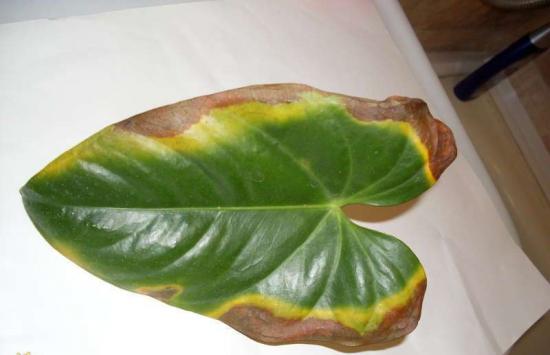
If you realize that you watered the plant too much and this is causing brown spots on the anthurium leaves, what to do:
- stop watering and spraying; it is better to simply wipe the leaves of the plant with a damp cloth
- observe, if spots appear in large numbers, then the roots are rotten and replanting is required
Prepare the soil, treat it with a solution of potassium permanganate or fungicide. Carefully remove from the pot, clean the roots from the soil, cut off any damaged ones (healthy roots are white and elastic), treat the cuts with charcoal (pharmaceutical activated one is suitable), dry for an hour. Plant in new soil and cover the top with moss.At first, spots may still appear, but not as intensely. Water little and rarely; the flower tolerates drought better than overwatering.
Infectious diseases and pests
But sometimes it can happen that brown spots appear on anthurium flowers and leaves even if all growing conditions are met. Then it is worth suspecting infectious diseases. Most often, the flower is affected by fungal infections, less often by bacteria and viruses.
Fungal diseases that cause brown spots on anthurium leaves and how to treat:
- Septoria - a disease caused by a fungus, with this disease the spots are dark, with a lighter or yellowish tint at the edges. It is necessary to remove all affected leaves and treat with a fungicide. Phytosporin is suitable: 1.5 g per liter of water, spray, repeat after 10 days
- Fusarium is a fungal pathogen, infection is usually through the soil, the disease spreads from the roots, then the stems and leaves are damaged. It is necessary to treat with a fungicide, the disease is dangerous, often all measures taken do not lead to recovery
Another group of diseases is parasitic:
- aphid – it can be detected when examining the lower leaves, the aphid sucks the juices from the plant
- scale insect - a small pest, covered with a shell on top, affects the upper part
- thrips – feed on the cell sap of plants, the leaves gradually turn yellow and fall off
- mites are one of the most common parasites; when infected, the leaves turn yellow and dry out; the entire plant may die if the mites are not destroyed
When carefully examining indoor plants, parasites are not difficult to notice. To get rid of them, the flower is washed, parasites are removed and treated with an insecticide, for example Fitoverm or Agravertin.
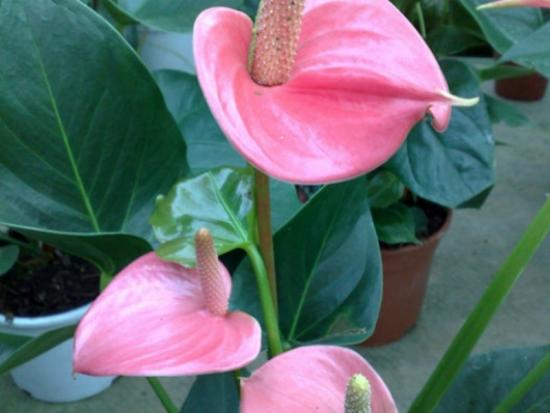
Sometimes a flower begins to hurt due to poor conditions, and subsequently an infection or parasites appear. A healthy plant has a good immune system; the best prevention of diseases is to create optimal conditions for this exotic plant.
What mistakes in plant care lead to the appearance of spots, what conditions does anthurium need for a good life, how to properly prepare the soil and how to get rid of pests and fungi you can see when watching the video:
.

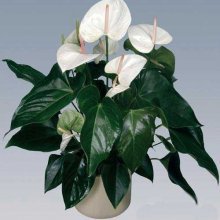
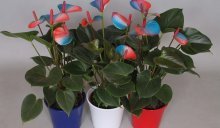
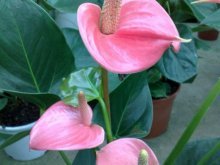
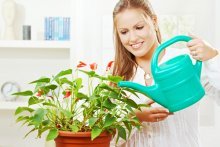
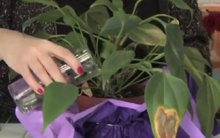
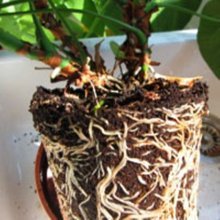
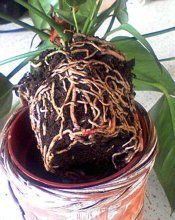
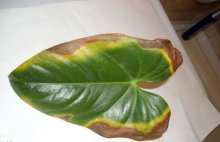
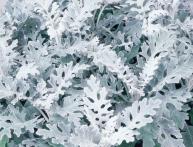
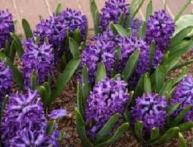
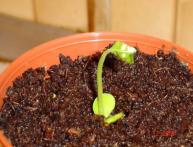
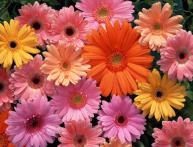
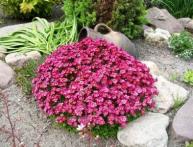
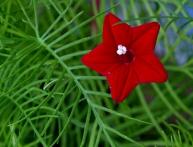
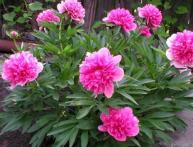
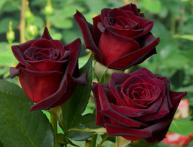
Comments
No matter how many times I started an anthurium, it died. Either the climate in my apartment is not suitable for him, or I did something wrong. I’ll use the recommendations from the article and try to buy anthurium again.
I also failed to make friends with this beautiful plant. They gave it to me several times, but the result was the same - the flower died. And it all started with brown leaves.
Finally I found the answer and solution to the problem with this flower. The leaves are starting to turn yellow all the time. Even the shoots that were transplanted are also affected and turn yellow at the edges over time. I'll try treating it with a fungicide. Judging by the description, this is septoria.
For my birthday, my husband gave me an anthurium, the first week it felt great, but today I saw brown spots on the leaves, maybe it’s time to replant it from a store-bought pot.